

Designation:Tristar class Large Cruiser
|
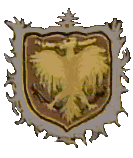
|
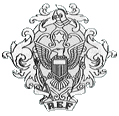
|
|||
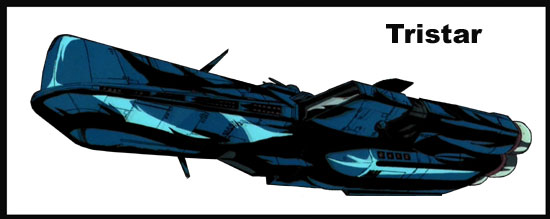
|
|||||
| Hull | Name | Fleet | Commissioned | Fate |
|---|---|---|---|---|
| SCB-01 | Tristar | SC | 2015 | Destroyed, 2030 |
| SCB-02 | Tenacious | REF | 2015 | Destroyed, 2030 |
| SCB-03 | Turgon | REF | 2015 | In reserve |
| SCB-04 | Tiamat | REF | 2015 | Destroyed, 2023 |
| SCB-05 | Thunderbolt | REF | 2016 | Destroyed, 2043 |
| SCB-06 | Theseus | REF | 2016 | Destroyed, 2029 |
| SCB-07 | Triffid | SC | 2016 | Destroyed, 2030 |
| SCB-08 | Trident | SC | 2016 | In reserve |
| SCB-09 | Thor | SC | 2017 | Destroyed, 2031 |
| SCB-10 | Trireme | SC | 2017 | Destroyed, 2030 |
| SCB-11 | Talon | SC | 2017 | Destroyed, 2031 |
| SCB-12 | Thutmosis | REF | 2017 | Destroyed, 2031 |
| SCB-13 | Tradewind | REF | 2018 | Destroyed, 2027 |
| SCB-14 | Thebes | REF | 2018 | Destroyed, 2030 |
| SCB-15 | Turbulent | REF | 2018 | Destroyed, 2043 |
| SCB-16 | Torbay | REF | 2018 | Destroyed, 2043 |
| SCB-17 | Tyrant | REF | 2019 | In reserve |
| SCB-18 | Twister | REF | 2019 | Destroyed, 2030 |
| SCB-19 | Taranis | REF | 2019 | Destroyed, 2031 |
| SCB-20 | Tsunami | REF | 2019 | In reserve |
| SCB-21 | Tisiphone | REF | 2020 | Destroyed, 2030 |
| SCB-22 | Takao | REF | 2020 | Destroyed, 2029 |
| SCB-23 | T'ien Shan | REF | 2020 | Destroyed, 2025 |
| SCB-24 | Trenchant | REF | 2020 | Destroyed, 2030 |
| SCB-25 | Titania | SC | 2021 | Destroyed, 2030 |
| SCB-26 | Tigris | SC | 2021 | Destroyed, 2030 |
| SCB-27 | Thunderer | REF | 2021 | In reserve |
| SCB-28 | Tiger | REF | 2022 | Destroyed, 2030 |
| SCB-29 | Ticonderoga | REF | 2022 | Destroyed, 2043 |
| SCB-30 | Tone | REF | 2022 | In reserve |
| SCB-31 | Tesla | SC | 2023 | Destroyed, 2030 |
| SCB-32 | Thorn | SC | 2023 | Destroyed, 2031 |
| SCB-33 | Terrible | SC | 2024 | Destroyed, 2030 |
| SCB-34 | Triumph | SC | 2024 | Destroyed, 2030 |
| SCB-35 | Truculent | SC | 2025 | Destroyed, 2031 |
| SCB-36 | Teutates | SC | 2026 | Destroyed, 2031 |
| SCB-37 | Tallyho | SC | 2027 | Destroyed, 2030 |
| SCB-38 | Temeraire | SC | 2028 | Destroyed, 2030 |
| SCB-39 | Texas | SC | 2029 | Destroyed, 2030 |
| SCB-40 | Talent | SC | 2029 | Destroyed, 2030 |
| SCB-41 | Trout | SC | 2030 | Destroyed, 2031 |
| SCB-42 | Tusk | SC | -- | Never completed,scrapped 2048; |
| SCB-43 | Tolkien | SC | -- | Never completed,scrapped 2047; |
| SCB-44 | Triton | SC | -- | Never completed,scrapped 2048; |
| SCB-45 | Thrasher | SC | -- | Never completed,scrapped 2049; |
| Hull | Name | Fleet | Commissioned | Fate |
|---|---|---|---|---|
| SBH-01 | Argonaut | SC | 2024 | Destroyed, 2030 |
| SBH-02 | Achates | SC | 2024 | Destroyed, 2030 |
| SBH-03 | Antietam | SC | 2024 | Destroyed, 2030 |
| SBH-04 | Anzio | SC | 2025 | Destroyed, 2030 |
| SBH-05 | America | SC | 2025 | Destroyed, 2030 |
| SBH-06 | Audace | SC | 2025 | In reserve |
| SBH-07 | Ayanami | SC | 2026 | Destroyed, 2030 |
| SBH-08 | Akagi | SC | 2026 | Destroyed, 2030 |
| SBH-09 | Ark Royal | SC | 2027 | In reserve |
| SBH-10 | Asmodean | SC | 2027 | Destroyed, 2030 |
| SBH-11 | Aurora | SC | 2028 | Destroyed, 2030 |
| SBH-12 | Albion | SC | 2028 | Destroyed, 2030 |
These ships were built at the Robotech Factory Satellite (a.k.a Space Station Equality), and after 2023 at Moon Base Luna and entered service from 2015 through 2030.
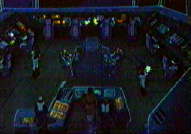
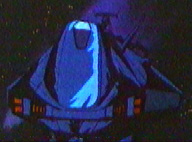
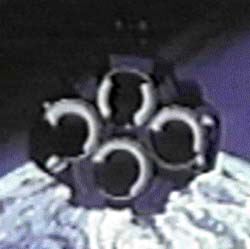
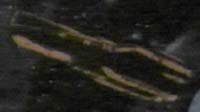
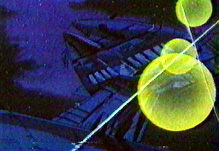
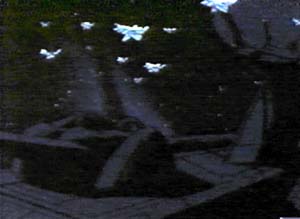
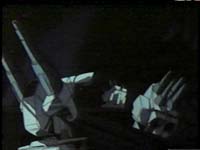

 cannon in a low lying round turret. The cannon can fire 400 MJ per second of particle energy as short duration beams or as enclosed particle packets ('disks') with an effective range of 300,000 km. This cannon is not quite capable enough to be effective against larger ships than Re-entry pods, Assault Carriers or Shell-dor carriers.
cannon in a low lying round turret. The cannon can fire 400 MJ per second of particle energy as short duration beams or as enclosed particle packets ('disks') with an effective range of 300,000 km. This cannon is not quite capable enough to be effective against larger ships than Re-entry pods, Assault Carriers or Shell-dor carriers.
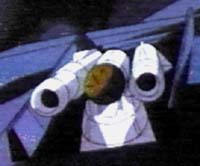 The RG-2 mount is designed to deliver heavy firepower on very close targets. A double barreled rail gun with a round sensor between the barrels, the RG-2 is stored inside the hull, but elevates upwards from under movable panels into firing position. The RG-2 fires 0.227 kg KPI rounds at 25 kps, giving the rounds a kinetic impact energy of 71 MJ. Maximum effective range for this system is 20 km against mecha sized targets, maximum rate of fire is 120 rounds per minute.
The RG-2 mount is designed to deliver heavy firepower on very close targets. A double barreled rail gun with a round sensor between the barrels, the RG-2 is stored inside the hull, but elevates upwards from under movable panels into firing position. The RG-2 fires 0.227 kg KPI rounds at 25 kps, giving the rounds a kinetic impact energy of 71 MJ. Maximum effective range for this system is 20 km against mecha sized targets, maximum rate of fire is 120 rounds per minute.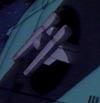
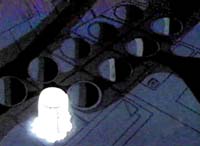
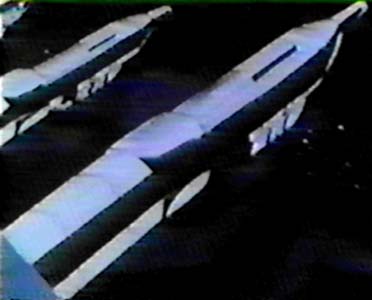 The SLBM-sized Skylord is a rocket with a special 3 MT nuclear fusion warhead that accelerates at 10 g throughout its flight and has a delta-v of 8 kps. A conventional warhead can also be mounted. The two double ramps are located in the forward dorsal hull.
The SLBM-sized Skylord is a rocket with a special 3 MT nuclear fusion warhead that accelerates at 10 g throughout its flight and has a delta-v of 8 kps. A conventional warhead can also be mounted. The two double ramps are located in the forward dorsal hull.
See Naval air group compositions for a detailed summation.
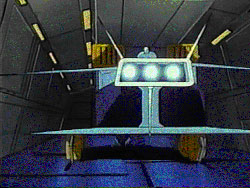
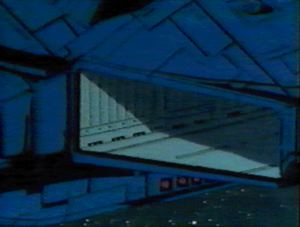
Note:
The Tristar can accommodate 72 additional fighters by using the launch bays as additional hangars, with the mecha tied down for storage rather than in stalls. However, this was universally unpopular with the pilots as recovery of the additional fighters was not possible, unless a loss rate of 33% was exceeded. Adverse effects on morale caused this method to be discontinued.
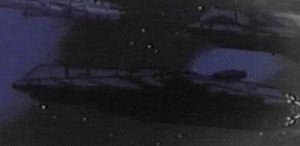
In profile, the Tristar class has almost exactly the same silhouette as the Battle class heavy destroyer. However, there are important differences: the engines are moved out of the sponsons and into the main hull, where they are mounted in a diamond pattern; the sponsons mate to the hull much more gradually, and the overall size is dramatically enlarged. The main mecha hangars, four double level bays, open to the front of the sponsons.
The cannon armament is extensive, and is concentrated on the forward dorsal deck. From front to aft are a rail gun turret, one heavy and two medium particle beam mounts, then another rail gun turret after which the command tower rises from the deck. Laser turrets cover all other firing arcs. The missile armament is formidable, with heavy rocket launchers for the powerful Skylord forward, and medium Spacelord anti-ship missiles more to the rear. The weak point of these vessels are the limited point defense capabilities, and the limited firepower that can be brought to bear to the rear and ventral arcs.
The Argonaut sub-class replaced the two smaller mecha bays with additional Skylord rocket launchers, backed by the large magazines required to provide six missiles for each launch ramp. This reduced the mecha complement with almost 50%, but provided the Southern Cross, the only service to commission these ships, with a heavy battlecruiser that could provide sustained missile barrages. In addition to this, the bow section was redesigned with a longer, but lower and lighter superstructure which made for better range, at the cost of less crew quarters. However, since the crew on the Argonaut was smaller than that on the Tristar in any case, the net result in habitability was negligible.
As the smallest ships capable of independent operations, the Tristars and Argonauts are equipped with a fold drive.
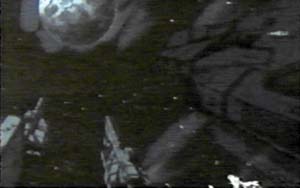
The Tristar class large cruisers are the smallest fleet command ships ever operated by the REF, and the heaviest units in the SC Tactical Space Corps. The RDF designed the class initially as a recon cruiser, intended to scout systems for enemy presences. This was very useful in the recon operations that tried to uncover the precise location of Tirol prior to the departure of the SDF-3. After this, the RDF ships were divided under the Southern Cross and the REF, while series production for the Southern Cross continued on the moon. Their designated task in the REF was to act as heavy escorts and escort commanders for the larger ships, to be capable of leading a detached battle group of destroyers on independent operations, and to give support for the Tokugawa class of landing ships. In the Southern Cross, they were the flagships and main battle line units of the Tactical Space Corps.
For these tasks, the Tristars carried a number of mecha, and a powerful anti-ship missile armament. Yet, to use as few resources and money as possible, the Tristars were made as small as was feasible without compromising their combat efficiency.
 Because of this, several compromises had to be made: the heavy anti-ship armament was concentrated on the dorsal and bow, with only minimal attention to the other arcs, and the ships themselves were considered cramped by their crews. However, the class performed as designed, and if there are comments on their performance, blame must be laid solely with their design criteria.
Because of this, several compromises had to be made: the heavy anti-ship armament was concentrated on the dorsal and bow, with only minimal attention to the other arcs, and the ships themselves were considered cramped by their crews. However, the class performed as designed, and if there are comments on their performance, blame must be laid solely with their design criteria.
To improve the missile firepower of the Southern Cross, a variant of the Tristar was procured, the Argonaut class heavy battlecruiser, described above. Because of the cramped living conditions and too concentrated armament, further series production by the REF was not pursued, with that service designing enlarged Tristar variants, a design and building proces that lead, through numerous paper designs and small numbers of intermediate ships, to the large and capable (not to mention more comfortable) Ikazuchi class large cruiser. For all its faults, though, the Tristars and Argonauts were fine vessels that were fought gallantly by their crews, no matter the circumstances.
Because of the high importance of the Pioneer mission, twenty-two of the thirty Tristar-class cruisers built by the date of the SDF-3's departure were assigned to the REF task forces, either as escorst for the REF flagship or as command ships for the out-system flotillas searching for the homeplanet of the Robotech Masters. This initially left only eight Tristars as the largest operational ships in the Solar System, until production of additional vessels increased this number.
During the search missions, several Tristar class cruisers met with untimely ends. The Tiamat was destroyed during the first engagement of the SDF-3 Pioneer, when she ran afoul of an automated Tirolian defense system using laser satellites. The T'ien Shan was destroyed in 2025 by a Zentraedi missile barrage, and the Tradewind (in 2027) and Theseus (in 2029) were destroyed when they stumbled on Tirolian colonies that retained enough protoculture to power their defenses for a short period. Also in 2029, the Takao was destroyed by an alien rail cannon emplacement.
Eight REF Tristar cruisers left with the assault waves against the Robotech Masters on the relief expeditions for Earth. Of these eight, the Tenacious, Thebes, Twister, Tisiphone, Trenchant and Tiger were destroyed in the various Southern Cross offensives against the Tirolian fleet. The final two, Thutmosis and Taranis, were destroyed in the Invid Invasion. Immediately following that invasion, all REF vessels, save for a few guard vessels for the Robotech Factory Satellite, left in the counterattck against the Regess. Of these, Thunderbolt, Turbulent, Tone, Thunderer, Ticonderoga and Torbay were grounded on Earth in the liberated enclaves, to serve as logistics centers for the forces and as emergency evacuation vehicles, should the troops be overrun. When the Invid attack came, only the Tone and Thunderer made it to Moon Base Luna. One other REF vessel, Tyrant, became part of the Earth System Defense fleet, operating from Moon Base Luna during the Invid occupation and patrolling the system against off-Earth Invid incursions (which never materialised). After the war, these three ships, together with the Turgon and Tsunami, which had stayed behind as guard vessels, were placed in reserve in 2047. They are, with the Southern Cross Trident, the only survivors of 41 commissioned Tristar vessels.
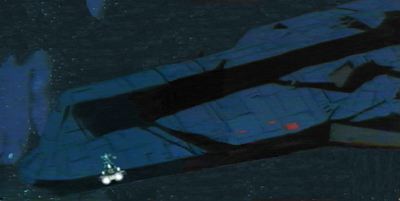
The Southern Cross vessels of the Tristar class suffered even heavier losses than the REF allotment. The class ship, Tristar, became the flagship of General Emerson, and was destroyed in the latter stages of that war when she was fatally damaged and then hurled by her crew into a Mothership, where she self-destructed. Other Southern Cross ships to be destroyed by the Tirolians were the Triffid, Trireme, Titania, Tigris, Tesla, Terrible, Triumph, Tallyho, Temeraire, Texas and Talent.
The Invid surprise attack a few months later claimed almost all other Tristars in the Sol System, most before they had even had a chance to open fire. In a matter of a few hours, the Thor, Talon, Thorn, Truculent, Teutates, and Trout were destroyed, most with all hands. The single Southern Cross survivor of this class is the Trident. Damaged in the Second Robotech War, she was undergoing repairs at Moon Base Luna. However, she had not yet completed her refit at the time of the Invid Invasion, and she remained in her drydock until the yard personel finished her after the REF counter attack, whereupon she joined the Earth System Defense fleet, and entered the reserve in 2047 with the other Tristar survivors.
The Argonaut subclass fared even worse against the Robotech Masters. Of the 12 vessels, no less than 10 (Argonaut, Achates, Antietam, Anzio, America, Ayanami, Akagi, Asmodean, Aurora and Albion) were destroyed by the Tirolian fleet, and the two survivors, Audace and Ark Royal, were heavilly damaged. After the war, interrogations showed that the Tirolians had assigned targetting priority to these vessels, the most capable ship killers in the Southern Cross fleets. The two survivors were under repair on the moon during the Invid invasion, and the rest of their life was comparable to that of Trident. They too, are now in reserve in the Tranquillity Sea ship depot.
See Image Gallery.
Return to Southern Cross Naval
index.
Return to EF Naval index.
Go to Robotech Reference Guide Home Page
Robotech (R) is the property of Harmony Gold. This document is in no way intended to infringe upon their rights.
Content by Pieter Thomassen and Peter Walker with Robert Morgenstern